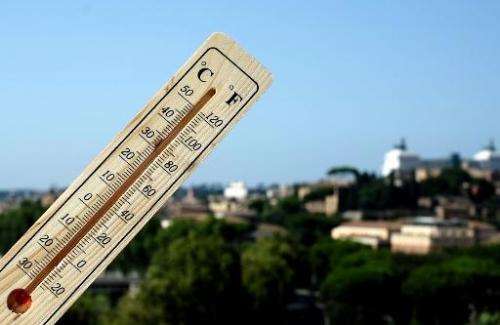Formation of a heat wave. Credit: U. S. National Weather Service
Scientists who a decade ago found that global warming had doubled the risk of an extremely hot summer in Europe reported on Monday that such an event was now 10 times likelier.
In 2004, experts at Britain's Met Office calculated that man-made carbon emissions had doubled the risk of an extreme summer heatwave when compared to the historical average.
Statistically speaking, such an event—defined as temperatures 1.6 degrees Celsius (2.9 degrees Fahrenheit) above the 1961-1990 average for June-August—would occur every 52 years.
In the new study, the same team revisited the scenario in light of a surge of warming since then, using better computer models to crunch the data.
Under today's conditions of warmth, the heatwave would occur roughly twice every decade, not twice a century, they found.
The research, published in the journal Nature Climate Change, focussed as before on France, Germany and Italy.
These were the countries that in 2003 bore the brunt of Europe's hottest summer since reliable records began.
Some estimates put the death toll at around 30,000, but a study in 2008 suggested more than 70,000 people in 16 countries died as a result of the heatwave.
Reservoirs and rivers ran low or dried up, food prices rose because of livestock deaths and crop losses, forest fires broke out in southern Portugal and Spain, and melting snow and glaciers in the Alps caused rock falls.
In their 2004 appraisal, the British scientists found that a 2003 event—whose temperature was a whopping 2.3 C above the long-term average—was statistically likely to occur on scales of a thousand years or more.
A thermometer shows 40 degrees Celsius at 16:30 in Rome, Italy, on July 28, 2013
Their latest assessment put the likelihood at nearly once a century—every 127 years.
Temperatures in Western Europe were 0.81 C warmer in the decade of 2003 to 2012 compared to 1990-1999, a rise overwhelmingly ascribed to man-made carbon gases.
Hot 2100
With an eye on heatwave frequency by the turn of the century, the new study reiterated a pessimistic tone sounded in 2004.
It looked at four models to predict global warming by 2100, each based on different levels of greenhouse gases.
Even under the most optimistic emissions track, "by the 2040s a summer as hot as 2003 will be very common," the probe said.
Under the highest emissions—which is the current trajectory—"the 2003 summer will be deemed an extremely cold event by the end of the century," it said.
The scientists said it was time for European planners to incorporate heatwave resilience into their strategies to help the public cope.
"The perception of extremely hot summers in Europe is set to change markedly over the next few decades," they warned.
The World Meteorological Organisation (WMO) defines a heatwave as five or more consecutive days in which the temperature exceeds the average local maximum temperature by 5 C.
The study, led by Nikolaos Christidis at the Met Office's Hadley Centre in Exeter, southwestern England, coincides with a new round of UN climate talks in Lima.
The negotiations aim at keeping warming to within 2 C beyond pre-industrialisation levels, when coal, oil and gas began to be used abundantly.
More information: Nature Climate Change, dx.doi.org/10.1038/nclimate2468
Journal information: Nature Climate Change
© 2014 AFP
























